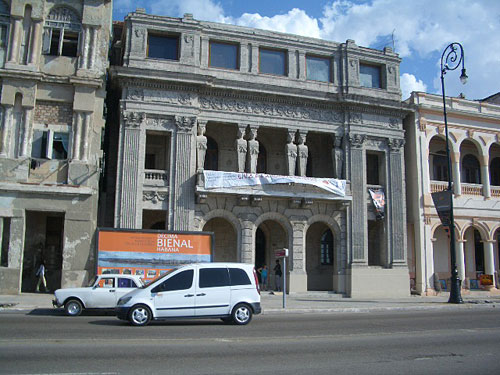
 |
 |
CHINESE ART FROM TODAY GRANTS CONTEMPORARINESS TO THE TENTH HAVANA BIENNIAL
by Yudelsy Fundora Martínez
Numerous galleries and institutions devoted to the fine arts in the world, such as the Sao Paulo Museum of Art, Brazil, and the Modern Art Institute of Valencia, Spain , have granted attention in recent times to the art produced in China these days. Since the opening of the 21st century, the quality and validity of its proposals have earned Chinese art a place of respect in the most important exhibition halls at global level.
During the upcoming months of March and April, the Tenth Havana Biennial will be the ideal pretext to present in Cuba a large number of the most representative aesthetics of the fine arts production of the Asian giant and thus nourish the centenary relations that exist between both nations.
Pieces by young artists born in the decades of 1960 and 1970 that give testimony of a reality in constant change and development and at the same time reflect an accelerated appropriation of western practices without renouncing to the commitment with their context and cultural legacy will be exhibited to the Cuban public.
The public attending the Biennial will enjoy the opportunity to valuate fairly today's Chinese art through an exhibition characterized by the uniqueness of the various aesthetics and supports.
The Asian nation will be represented by the group project “ China : contemporary art review” and two solo shows of guest artists Liu Xiaodong and Chen Xiaoyun.
The joint project, that will have its premiere in the Island, was initially conceived for the Asian Pacific Weeks Festival, Berlin , 2007, and brings to Cuba a group exhibition of six Chinese artists: Chen Bo, Qiu Xiaofei, Wang Chengyun, Wang Qinsong, Xiong Yu and Zhou Wenzhong.
These creators, who work independently, are representative of the Chinese contemporariness, according to Tereza de Arruda, curator of the Berlin exhibition, whose words for the Cuban version of the project appear in the catalogue to the Tenth Havana Biennial.
Born in 1973, Chen Bo pays tribute to daily life, to the beauty of the common characters that appear coherently in a painting characterized by long and expressive brush strokes.
Qiu Xiaofei, still younger, also chooses to present the apparently ordinary. He rescues scenes from his childhood in a country with socialist precepts in force, to explain the present crossbreeding of political-social action. In addition to painting, Xiaofei creates installations.
Wang Chengyun's painting establishes a dialogue between the accelerated urban evolution and its social consequences. Prostitution among the youth is one of his most recurrent themes.
Wang Qinsong uses photography as support to reflect on China and the world. The artist presents sceneries that recreate the images and in many cases distort reality.
According to de Arruda, Xiong Yu explores a fantastic figure, an androgynous creature indifferent to the context that surrounds it.
Zhou Wenzhong's painting moves away from the Chinese academic school of painting marked by social realism to represent his country's history through fantastic beings and surrealist scenes.
Liu Xiaodong, a bachelor in oil painting at the Central Institute of Fine Arts in Beijing and one of the exponents of the so-called cynical realism will be present at the Biennial with a solo show. This artist has exhibited his works in the United States and France .
The other creator invited to participate is Chen Xiaoyun, one of the representatives of China 's most contemporary video art. His works have been exhibited in Italy , the United States , France and Germany . It was U.S. curator Julia Herzberg who proposed his attendance to the Biennial.
Hezberg also proposed Korean artist and curator Yong Soon Min, who will show a video projection at the Cuban event.
The ample Chinese representation foreseen for this Biennial edition is an essential element of this event. The fine arts produced in a socialist country that is also one of the greatest world powers in the social, political and economic spheres, widely confirm the urgency and truthfulness of the central theme proposed by the Biennial this year: “Integration and resistance in the global era”. The Chinese presence in Havana is a testimony of the work displayed for more than two decades by Wifredo Lam Center, organizer of the this event that since its second edition in 1986 extended its scope to Africa, the Middle East and Asia in defense of the so-called peripheral cultures, many times segregated and apart from the standards set by the western world.
